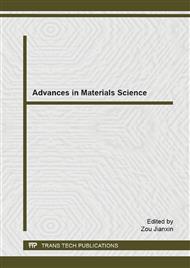[1]
J. Kaemwich, Haupt M J, Svoronos Spyros A, et al. Combining metabolic engineering and metabolic evolution to develop nonrecombinant strains of Escherichia coli C that produce succinate and malate. Biotechnology and Bioengineering, (2007), 995.
DOI: 10.1002/bit.21694
Google Scholar
[2]
Zeikus, J., M. Jain, and P. Elankovan, Biotechnology of succinic acid production and markets for derived industrial products. Applied microbiology and biotechnology, 51(5) (1999), 545-552.
DOI: 10.1007/s002530051431
Google Scholar
[3]
Willke, T. and K.D. Vorlop, Industrial bioconversion of renewable resources as an alternative to conventional chemistry. Applied microbiology and biotechnology, 66(2) (2004), 131-142.
DOI: 10.1007/s00253-004-1733-0
Google Scholar
[4]
Lee, P., et al., Batch and continuous cultures of Mannheimia succinici producens MBEL55E for the production of succinic acid from whey and corn steep liquor. Bioprocess and biosystems engineering, 26(1) (2003), 63-67.
DOI: 10.1007/s00449-003-0341-1
Google Scholar
[5]
Chen KQ, Jiang M, Wei P, Yao JM and Wu H, Succinic acid production from acid hydrolysate of corn fiber by Actinobacillus succinogenes. Appl Biochem Biotech, 160(2010), 477–485.
DOI: 10.1007/s12010-008-8367-0
Google Scholar
[6]
Wang Y.Z. Li K. P, Huang F. et al. Engineering and adaptive evolution of Escherichia coli W for l-lactic acid fermentation from molasses and corn steep liquor without additional nutrients. Bioresource technology, (2013), 148.
DOI: 10.1016/j.biortech.2013.08.114
Google Scholar
[7]
Lee, J., Lee, S.Y., Park, S., Fed-batch culture of Escherichia coli W by exponential feeding of sucrose as a carbon source. Biotechnol. Techniques, 11 (1) (1997), 59–62.
DOI: 10.1007/bf02764454
Google Scholar
[8]
Zhao J.F. Hua B.W. Wang Y.Z. et al, Fermentation Characteristics of Engineered Escherichia coli for Succinic Acid Production. Proceedings of 2013 International Conference on Materials for Renewable Energy and Environment, (2013): 4.
DOI: 10.1109/icmree.2013.6893836
Google Scholar
[9]
Zhou, S., et al., Betaine tripled the volumetric productivity of D (-)-lactate by Escherichia coli strain SZ132 in mineral salts medium. Biotechnology letters, 28(9) (2006), 671-676.
DOI: 10.1007/s10529-006-0033-4
Google Scholar
[10]
Causey, T., et al., Engineering Escherichia coli for efficient conversion of glucose to pyruvate. Proceedings of the National Academy of Sciences of the United States of America, 101(8) (2004), 2235.
Google Scholar
[11]
Zhou S, Iverson AG, Grayburn. Doubling the catabolic reducing power (NADH) output of Escherichia coli fermentation for production of reduced products. Biotechnol Prog, 26(1) (2010), 45–51.
DOI: 10.1002/btpr.302
Google Scholar
[12]
Jahreis K, Bentler L, Bockmann J, Hans S, Meyer A, Siepelmeyer J, Lengeler . Adaption of sucrose metabolismin the Escherichia coli wild-type strain EC3132. J Bacteriol, 184(19) (2002), 5307–5316.
DOI: 10.1128/jb.184.19.5307-5316.2002
Google Scholar


